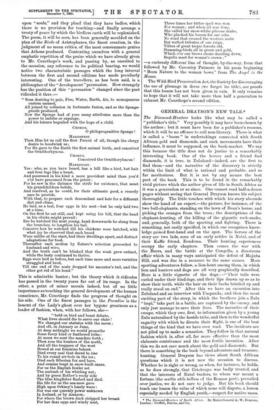GENERAL DRAYSON'S NEW TALE.*
The Diamond-Hunters looks like what may be called a "publisher's title." Very possibly it may have been chosen by the author ; but it must have been for a publisher's reasons, which it will be no offence to call non-literary. There is what is called a " boom " in undertakings connected with South African gold and diamonds, and such movements have their influence, it must be supposed, on the book-market. We say this because the title does not do justice to a remarkably interesting book. One of the heroes and a friend find diamonds, it is true, in Zululand—indeed, are the first to find them—and the narrative of the discovery is strictly within the limit of what is rational and probable, and so far meritorious. But it is not by any means the best part of the book. This is to be found in the remarkably vivid picture which the author gives of life in South Africa as it was a generation or so since. One cannot read half-a-dozen pages without seeing that General Drayson knows his subject thoroughly. The little touches, with which his story abounds show the hand of an expert,—the picture, for instance, of the two bull-elephants, standing on the lawn of Dean's house, and picking the oranges from the trees ; the descriptions of the elephant-hunting, of the killing of the gigantic rock-snake, and, generally, both of the sporting and fighting. There is something, not easily specified, in which one recognises know- ledge gained first-hand and on the spot. The heroes of the story are two lads, sons of an early settler in Natal, and of their Kaffir friend, Eondema. Their hunting experiences occupy the early chapters. Then comes the war with the Boers, and the battle at the Congella, a disastrous affair which in many ways anticipated the defeat of Majuba Hill, and was due in a measure to the same causes. More sporting adventures follow, a lion-hunt among them, in which lion and hunters and dogs are all very graphically described. Here is a little vignette of the dogs :—" Their tails were curled under their hind-legs, and their lips drawn up so as to show their teeth, while the hair on their backs bristled up and really stood on end." After this we have an excursion into Zululand and an interview with Umpanda; and then the most exciting part of the story, in which the brothers join a Zulu " impi," take part in a battle, are captured by the enemy, and only just manage to save their lives. The narrative of their escape, which they owe, first, to information given by a young Zulu naturalised by the hostile tribe, and then to thewonderful sagacity with which he directs their flight, is one of the best things of the kind that we have ever read. The incidents are not piled up to make a sensation. They follow in that natural fashion which is, after all, far more effective than the most elaborate contrivance and the most fertile invention. After this we do not care much about the gold and diamonds. But there is something in the book beyond adventure and treasure- hunting. General Drayson has views about South African questions which it is not now the occasion to discuss. Whether he is right or wrong, as when, for instance, he holds, as he does strongly, that Cetehvayo was badly treated, and that the interests of Natal traders, to whom war meant a fortune (the multis utile bellum of the Roman poet), prevailed over justice, we do not care to judge. But his book should teach one lesson the value of which none will dispute, a lesson especially needed by English youth,—respect for native races.
* The Diamond-Hunters of South Africa. By Major-General A. W. Drayson. London : Griffith, Ferran, and Co.






















































 Previous page
Previous page